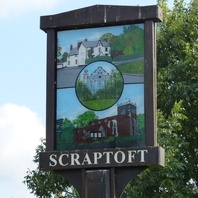
Viking Names
Scraptoft
There are two possibilities for the first element of Scraptoft, in the Gartree Hundred of Leicestershire. The first suggestion is that it is the Old Norse male personal name Skrápi (genitive singular Skrápa). Alternatively, the specific could be the Old Norse element skrap ‘scraps, scrapings’ potentially referring to arid barren soil which may be related to Modern Norwegian skrapmark ‘land thinly covered by grass’. This would be topographically appropriate as the settlement lies on a small area of sand and gravel on top of boulder clay. The second element of the name is Old Norse toft ‘building plot, homestead, curtilage’.
Read More
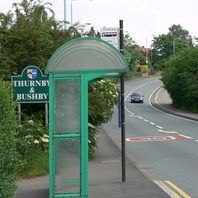
Viking Names
Thurnby
Thurnby, in the Gartree Hundred of Leicestershire, probably derives from Old Norse þyrne, þyrnir, þyrni ‘a thorn-bush’ and Old Norse by ‘a farmstead, a village’. It is also possible that the specific element is the Old Norse byname Þyrnir. However, when taken with the neighbouring parish Bushby these names appear to record an area of former scrubland. This land remained poorly exploited until the period of Scandinavian settlement. Some earlier spellings of the name show substitution of Old English þorn ‘a thorn-tree’ as the first element. Thurnby is now a joint parish with Bushby.
Read More
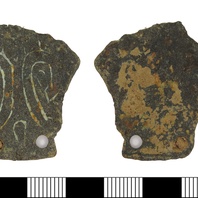
Viking Objects
Stirrup-Mount Fragment (LEIC-534DFF)
This copper-alloy stirrup-strap mount, classified as a variant of Williams Class A Type 1, is decorated with two sets of double curving incised lines that may represent beasts.
Read More
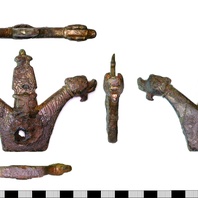
Viking Objects
Mystery Item
A gilded, copper alloy object that was clearly affixed to something else. The gilding shows that it was high status but its function remains a mystery.
Read More
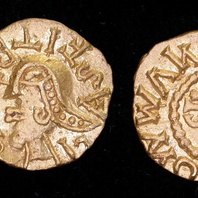
Viking Objects
Merovingian Tremissis (LEIC-6BAA60)
This Merovingian gold tremissis was minted in Bourges in the late 6th or 7th century. It is possible that it made its way to England prior to Viking incursions but it is equally likely that the Vikings brought this coin with them as plunder after raiding in Frankia.
Read More

Viking Names
Herrod
Herrøðr was thought to be the first element in the place-name Harby, Leicestershire. However, more recent scholarship indicates that the element is more likely formed from Old Norse hjọrð ‘herd’. Nevertheless, the name Herrøðr appears in various forms throughout medieval Scandinavia including on a Viking Age Gotlandic runic inscription. Also two individuals in Landnámabók ‘The Book of Settlements’ recounting the settlement of Iceland (c.870-930) are named Herrøðr.
Read More
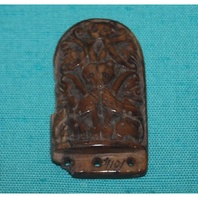
Viking Objects
Belt Terminal (L.A67.1864.3.0)
A belt terminal in an Anglo-Scandinavian zoomorphic style that was found in Leicester. It features two opposed ‘lions’, two central masks and acanthus scrolls. Strap ends or belt terminals came in various styles and were fairly common throughout the Viking world. They were used to decorate the ends of belts and to stop them getting damaged.
Read More
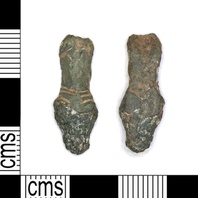
Viking Objects
Anglo-Scandinavian Strap-End (LEIC-1DD0CD)
This copper-alloy strap-end fragment is decorated in an Anglo-Scandinavian style consisting of a triangular cross-sectioned shaft which terminates in a triangular-shaped animal head. It is classed as a Thomas Class B, Type 4 strap-end which were introduced during the later eighth or early ninth century and remained popular into the eleventh century.
Read More
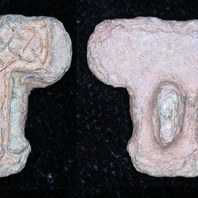
Viking Objects
Irish Gilded Mount (LEIC-09D1C8)
This fragment of a gilded copper-alloy mount is roughly T-shaped, and has a raised border around a panel of chip-carved interlace which has traces of gilding. It is possible that it made its way to England prior to Viking incursions but it is equally likely that the Vikings brought this brooch with them as plunder after raiding various areas in Ireland.
Read More
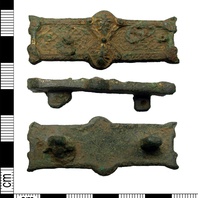
Viking Objects
Gilded Mount (LEIC-127138)
This mount is decorated with rope-like raised decoration, flanked by a plain raised edge. The centre of the mount is decorated with a raised ‘saltaire’ cross. Above and below this cross are semi-circular projections which form the upper part of human face masks which face each other. The remainder of the upper surface is filled with loose ‘chip carved’ interlace. The whole upper surface has patches of gilding, suggesting it originally covered the whole surface. It is possible that it made its way to England prior to Viking incursions but it is equally likely that the Vikings brought this brooch with them as plunder after raiding various areas in Ireland.
Read More

Viking Names
Ullesthorpe
The first element of Ullesthorpe, in the Guthlaxton Hundred of Leicestershire, is the Old Norse male personal name Úlfr (Old Danish Ulf), an original byname meaning ‘wolf’. It was a common name throughout the Viking diaspora. The second element is Old Norse þorp ‘a secondary settlement, a dependent outlying farmstead or hamlet’. The township names that line Watling Street and those to its north-east are predominately English in origin; however, Ullesthorpe, Catthorpe, and Bittesby are the exceptions. It is important to note that although Ullesthope has both an Old Norse specific and generic, Bitteby’s first element is Old English and Catthorpe’s is a feudal affix, which indicate only light Scandinavian settlement in the surrounding area. Ullesthorpe and Bittesby were formally a single land unit which Bittesby was later carved out. Ullesthorpe was likely the dependent village of Bittesby, and now has a narrow reach of land to its west which runs to Watling Street.
